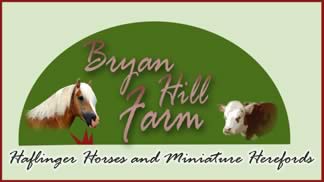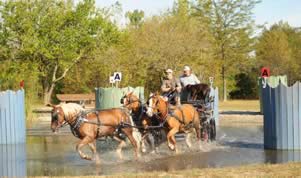The Littlest Biggest Herd
Downsizing with ‘minis’
Miniature Herefords provide big benefits, say Mayland couple
North Fork Journal (Broadway, VA)-November 18, 2009
Photos and article by Lauren Jefferson
MAYLAND – At first, the stubborn miniature Hereford bull calf won’t come. He likes being out in the pasture with the big cows, so he charges around, rolling his eyes comically, his curly-haired head tilted down, bony rump up in the air.
Four-year-old Allison Bryan waits patiently outside the pasture gate as her dad, Tim Bryan, tries to entice the calf out. She spent most of last summer halter-breaking the calf for the PeeWee Showmanship class at the Rockingham County Fair, so she’s seen all his shenanigans.
Eventually, Levi gives in to the temptation of food. When he does, Allison is right by his side with a currycomb to clean the dirt off his red and white coat.
Allison and her sister, Rachel, 6, are one reason why Tim and Debbie Bryan started raising miniature Herefords on their Mayland farm.
The Bryans wanted their children to learn the character-building lessons that working with animals can teach. And selling a few animals each year would help with the girls’ college fund, as well as supplement their income from Tim’s full-time work at his machine shop.
But bolstered by a renewed interest in small-acre farming, the Bryans’ 7-year-old hobby has grown to small business proportions. Their 40-head herd of miniature Herefords is the largest on the east coast.
Smaller is Better
Even before the couple purchased their farm outside of Broadway, they began researching what kind of livestock to raise. Of the 26 miniature breeds, the Hereford rose to the top of their list.
“What you see is what you get,” Tim said. “Miniature Herefords are not dwarfs. Some people think that. But they have the exact same conformation as a full-size cow. The full-size registry recognizes the purity of miniature breed.”
Among the benefits of miniature cows are hardiness to extreme temperatures and a tractable nature. Lighter on their feet, minis don’t tear a field up as much as full-size cattle and are not hard on the fencing, Tim said.
“A lot of people have the ‘bigger is better’ mentality, but you can produce as much or more beef with minis if you do the math and add in all the factors,” Tim said. “The feed conversion ratio is better than a full-size.”
While an average full-size Hereford weighs between 1,400-1,800 pounds, minis are between 500-800 pounds.
Miniature cows are graded by height and weight using a system of zeros, from the smaller and more expensive 0 (37-39 inches) to the larger 0000 cattle (43-45 inches at the hip).
The Bryans keep one full-size cow with several miniature cows in the pasture near the house to show visitors the size difference.
Hobby ‘A Lucky Break’
And there have been plenty of visitors.
In the first year, their Web site got 359,800 hits.
“For about the first three years, we had someone here every weekend, coming from as far away as Maine, Kentucky, Tennessee, Ohio,” Tim said. “They would plan their vacations around a visit out here. Every week, we’d show between three and six visitors around.”
He thinks the interest comes from several populations: hobby farmers with smaller parcels of land; older people who want to have something for their grandkids, and people who want their kids to grow up around animals.
“They will keep your pasture down and you can have a nice size herd on not a lot of acres,” he said, adding that while one full-size cow needs an acre, the same space can pasture about 2 to 2.5 cows.
They sell between 15 and 20 calves a year and have a long waiting list. Prices range from $2,500 to $5,000.
Miniature cows are more popular in the midwest and west, Tim said, but are gaining popularity on the east coast.
“We just got in at the right time,” he said. “It was a lucky break.”
While they don’t plan to ever get into the meat business, the Bryans started butchering their stock about three years ago for their own consumption.
“We had to stop naming them to do that,” Tim said.
But there are some “keepers” out in the pasture, Debbie said, including Rachel’s Levi.
For more information, visit www.bryanhillfarm.com.
Copyright (c) 2009, Byrd Newspapers, All Rights Reserved. Used with permission.

